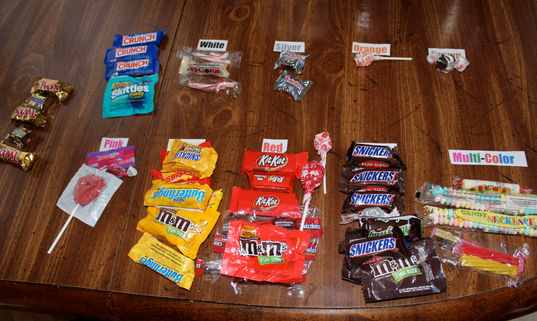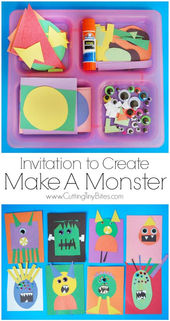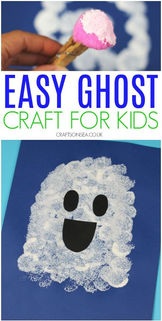Halloween and the Letter H
Happy early Halloween! At our preschool we would normally have a party day for the kids this week, but we don't call it a Halloween party and we don't wear costumes. Instead, we have "Pajama Day" for Pre-K and "Wear Orange Day" for the three-year-olds. Our activities in this week's newsletter, though, are mostly Halloween themed. Below, we have a couple of videos that would either fit with Pajama Day or Halloween: a read aloud of the book "When Sheep Sleep," and a directed-drawing of a silly monster, along with some others we did not create (that have more of a Halloween theme). Please, if your child ends up doing the directed-drawing, I would love it if you sent me a picture so I can share it on Facebook! If you are uncomfortable with some of the craft projects or activities because they have witches or something that may be scary, feel free to ignore them. Whatever you decide to do this week, I hope you have fun and stay safe!
Storytelling Skills
Being able to tell a story, whether it's an original story, or retelling a classic, is yet another skill that points towards kindergarten readiness and is an important life skill. Children first learn storytelling from seeing (or hearing) it done. When we model storytelling by reading to them, or simply telling a story in our own words, it helps children to learn new vocabulary, improve listening skills, become more aware of their culture and roots, develop creativity and imagination, sharpen their memory, become better communicators, increase their knowledge, and become more empathetic towards others. When children learn how to tell a story themselves, they are engaging their brain muscles to think critically, organize thoughts and ideas, and use their oral language skills.
When working on storytelling skills with children, it doesn't have to be too formal. If there is a book that you like to read with your child a lot, maybe it's your child's turn to "read" the story to you now. Books like If You Give a Mouse a Cookie, The Very Hungry Caterpillar, Brown Bear Brown Bear, There Was an Old Lady Who Swallowed a Fly, are all stories where the pictures may be helpful for retelling if your child needs some memory cues. A helpful strategy for improving storytelling skills, courtesy of Michelle Crouch of Parenting Magazine, is to suggest a topic for the story. You could also make a game out of it, even. For example you may put a bunch of random items in a bag, and take turns pulling items out of the bag, and as you do so, incorporate that item into the story. Similarly, you could print or make story cubes or stones with pictures on them to give ideas that may be part of the story as well.
Crouch also recommends giving a story structure, sometimes called a "story spine" in the improv world. In this method, you may start with "Once upon a time ..." and let your child respond. Then you fill in the second line ("And every ... "). Then begin the next line ("Until one day ... ") and let your child add the plot twist. The full story structure is as follows:
Once upon a time...
And every day...
Until one day...
And because of that...
And because of that...
Until finally...
And ever since that day...
One of my favorite ways to tell stories is through play. Skits, puppet shows, acting with dolls and toys are all wonderful opportunities to practice story-telling skills. My husband's family used to create what they called "Never-Ending Stories," as well. This activity involved a roll of butcher paper (but you can use other paper and tape it together) unrolled part-way on a large table or the ground. As my husband and his brother invented parts of the story, they drew pictures of what was happening. For example, my husband drew a castle on the paper as he was describing the setting of the story, then his brother drew a knight on a horse approaching the castle and began that part of the story. They took turns in this manner, drawing and adding onto the story. Now, my children like to tell "Never-Ending Stories." If you're not feeling creative, though, just spending time each day sharing stories from your day as a family can be helpful (ie: Mom tells a story about her trip to the grocery store; Dad tells about the funny thing that happened during work, and Daughter tells the story about the neighbor's dog getting out of his fence that morning).
What stories will you be telling today?

Zoo Phonic Friend: Honey Horse, Hh
This week's animal friend is Honey Horse. This may be one of the easier Zoo Phonic animals to find around here if you're looking to visit one. If you want to just learn about them from a video, though, one is included below. As with all of the letters, it is helpful for children to learn how to say the letter's sound (phonic), identify the letter in both upper and lower case forms, and become familiar with other words that begin with that phonic. The Zoo Phonics curriculum has movements that go with each animal for the kinesthetic learners out there. Honey Horse's movement is to make a galloping sound with your hands on your legs. The letter H (or items that start with H) would serve as a good topic for a story. Many of the suggestions given for the previous letters of the alphabet would work for H as well.

Halloween or Pajama Day
Even though Halloween looks different this year for many of us, it doesn't mean we can't still have fun at home. The suggestions below include some art projects that are Halloween or candy-themed, games you can download, and some songs you can dance to. There are are a lot of fun ideas for activities that we wouldn't do other times of the year. My favorite, though, is the STEM (Science, Technology, Engineering, Math) activities, most of which involve candy. I love using candy for experiments because it's fun and if you don't want your child eating all the sugar, it puts the candy to a good use--education. You can build a simple catapult out of popsicle sticks to fling candy and estimate then measure which candy went farthest. You can take candy pumpkins, gumdrops, or candy corn and toothpicks to build a structure (this works great with marshmallows too!). You could try to dissolve candies in various liquids and observe the effects. Another idea is to simply sort all of the candies by various factors (ie: type of candy, color of packaging, etc.). If you're looking for something more active, the "Bones Bones" song from Go Noodle (below) teaches about the different bones in our body, which would tie in nicely with a skeleton craft project. Cosmic Kids Yoga is always great for movement as well; this week's workout is about a little witch named Ruby Broom.
Maybe Pajama Day is more of your style; in which case, there are a number of fun activities you can do in your jammies. There are some great books you can read, like Llama Llama Red Pajama, and I included a few activities to accompany this story below, like making differently textured quilt blocks from play dough, or designing pajamas for a llama. There is a fun version of the "Hokey Pokey" in the gallery below, called "The Pajama Pokey," and YouTube has some fun night time yoga story workouts as well.
























